The overhead cable extension, often called the cable overhead triceps extension, is an isolation exercise that works the tricep, especially good at targeting the long head of the triceps.
This exercise requires a cable machine and a rope attachment. The overhead position and resistance from the cable isolate the triceps and challenge them to work through the full range of motion.
This exercise is typically done using a cable machine, which provides consistent resistance throughout the movement.
It is also a versatile exercise that can be modified to target different areas of the triceps. Also, the overhead cable extension is a low-impact exercise, so it’s a good choice for people with joint pain.
- Also, Known As: Overhead cable pull, overhead rope press, overhead tricep pull
- Main Muscles: Triceps
- Exercise Type: Strength
- Exercise Mechanics: Isolation
- Difficulty Level: Beginner
- Equipment Needed: Cable column, rope attachment
Want to take your gains to the next level? Discover your daily calorie needs with our free TDEE calculator
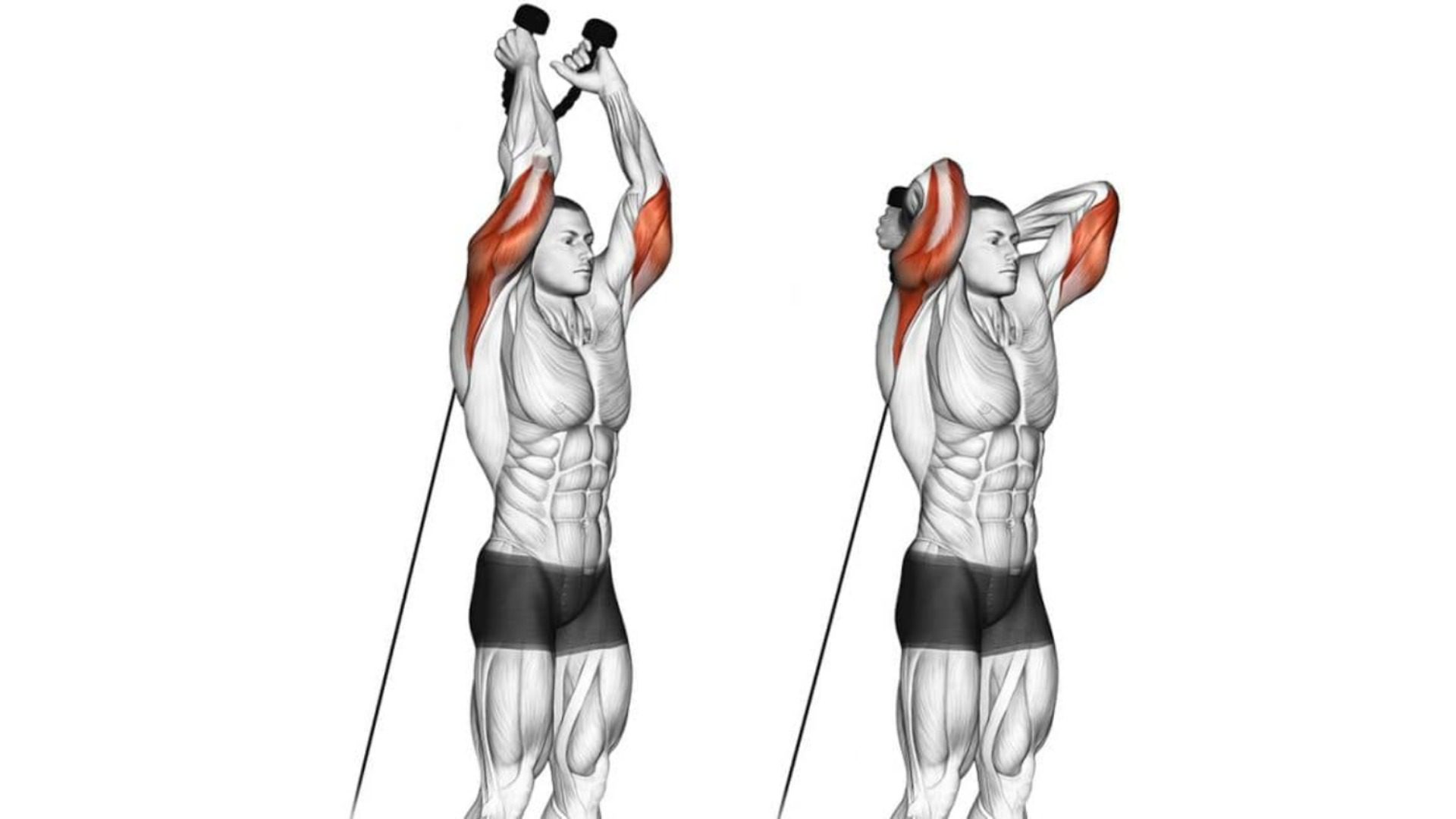
- Overhead Tricep Extension Muscles Worked
- How To Do Overhead Cable Tricep Extension
- Tips and Techniques
- Cable Overhead Extension Variations
- 1. High Pulley Cable Overhead Extension
- 2. One Arm Cable Overhead Extension
- 3. Lying Cable Overhead Tricep Extension
- 4. Kneeling Overhead Cable Tricep Extension
- 5. Seated Cable Overhead Tricep Extension
- FAQs
- Overhead cable tricep extension low pulley vs high pulley
- Is the Overhead Cable Tricep Extension safe for people with elbow pain?
- Can the Overhead Cable Tricep Extension be performed at home
Overhead Tricep Extension Muscles Worked
The overhead tricep extension is an isolation exercise, rather than a compound motion, that effectively isolates the tricep muscles.
- The primary muscle group worked by the tricep extension is your triceps.
- Secondary muscle groups that activate during overhead cable extension pull are biceps, forearms, lats, abs (rectus abdominis), obliques, and traps (trapezius).
How To Do Overhead Cable Tricep Extension
- Set up the pulley at the bottom and attach a rope or straight bar.
- Grasp each end of the rope or straight bar with a firm grip.
- Rotate your body away from the pulley and place your arms behind your head so that your elbows are bent and your triceps are stretched.
- Keep your elbows as close to your head as possible.
- Forcefully flex your triceps until your elbows are fully extended.
- Lower the rope in a controlled manner until you feel a significant stretch in your triceps, then repeat the movement.
To Stay Motivated: 150+ Gym Workout Motivational Quotes To Stay Fit
Tips and Techniques
- Avoid Elbow Flare-out. During a downward push, people tend to flare their elbows outwards, which can put unnecessary stress on the shoulder and chest muscles.
- Avoid Excessive Elbow Movement. Many people let their elbows sway back and forth during the movement. While you can technically lift more weight using this momentum, you are actually using your lats to complete the exercise.
- Focus on using controlled, deliberate movements to curl the bar. A slow controlled descent will increase time under tension, leading to more effective sets, and less risk of injury.
- Never load up to where you cannot maintain a stable body position. This is an isolation exercise that does not require maximum loads.
- Keep your arms close to your head for maximum triceps engagement.
- Incorporate proper rest, and nutrition into your exercise program. Rest for 24 to 48 hours before training the same muscle groups to allow sufficient recovery.
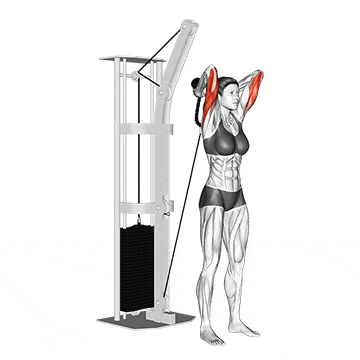
Cable Overhead Extension Variations
In this section, we will discuss the various ways of doing overhead cable tricep extension.
1. High Pulley Cable Overhead Extension
Cable High Pulley Overhead Extension is one of the best two-arm tricep cable extension exercises for upper body workouts.
This is the more advanced exercise, which works not only your triceps but also your torso, legs, and shoulders to fix your body in position.
With the high cable, you achieve a deeper stretch in the triceps during the eccentric phase. You can use various grip attachments (rope, bar, single-handle) to target the tricep from different angles.
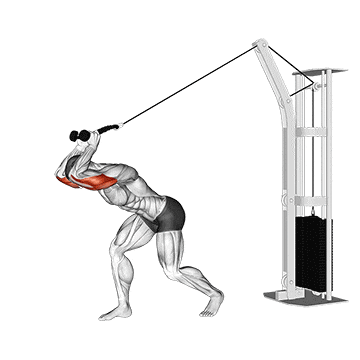
2. One Arm Cable Overhead Extension
When doing a tricep extension workout with a cable machine, you can add plenty of single-arm exercises to correct potential imbalances.
The single-arm setup provides greater flexibility in movement, allowing for full stretch and contraction of the triceps, especially the long head.
This exercise can be done standing or seated and targets each side of the triceps separately. It balances the strength of each arm and gives you an asymmetrical look.
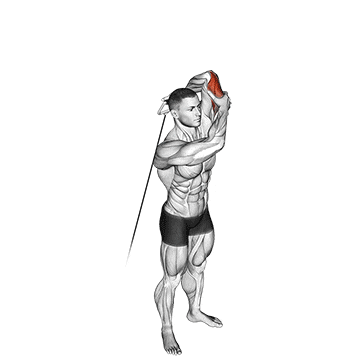
3. Lying Cable Overhead Tricep Extension
The Lying overhead tricep extension is a variation of the cable overhead extension that involves lying on a flat bench while extending the arms.
Compared to standing variations, the lying position minimizes stress on the lower back. Lying down removes the stabilization muscles from the equation and effectively isolates the triceps.
You can also adjust the bench angle to adjust the stress on different parts of the triceps.

4. Kneeling Overhead Cable Tricep Extension
The kneeling tricep extension is similar to the standing overhead tricep extension, but the stabilizing muscles are challenged as the body is more unstable.
When you’re in a kneeling position, it takes your legs out of the equation, so you can’t use them to help power the movement. This makes you use only your upper body strength, especially your triceps.
That extra focus helps you isolate the triceps more effectively, making the exercise more efficient at targeting that muscle.
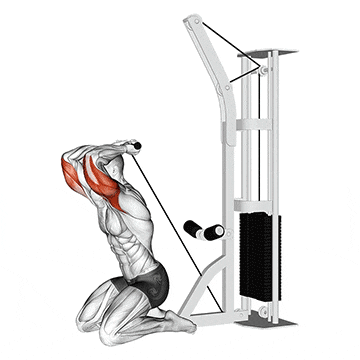
5. Seated Cable Overhead Tricep Extension
The Seated overhead cable tricep extension is an isolation exercise that targets the triceps muscle group.
This exercise is performed by sitting on a bench or seat with a cable machine and extending your arm overhead to perform the movement.
FAQs
Overhead cable tricep extension low pulley vs high pulley
The difference between an overhead cable Tricep extension performed on a low pulley and one performed on a high pulley lies in the position of the cable and the angle of the exercise.
- When using a low pulley, the cable is positioned at a lower height, which changes the angle of the exercise.
- On the other hand, the high pulley variation raises the cable’s height, changing the angle of resistance.
- There is very little difference in how much the tricep muscle is activated during exercise.
Is the Overhead Cable Tricep Extension safe for people with elbow pain?
The overhead cable tricep extension is a safe exercise for people with elbow pain, but it is important to approach this exercise with caution and proper form.
If you have any pre-existing elbow pain or injury, it is best to consult a physician or physical therapist before performing the exercise.
You should ensure that you use a light weight and focus on using proper form to avoid additional strain on the elbow joint.
Can the Overhead Cable Tricep Extension be performed at home
Yes, a resistance band can perform the Overhead cable tricep extension at home.
You will need a resistance band and a stable surface to anchor the band to perform the exercise.
If you don’t have a resistance band, you can perform alternative exercises to target the triceps at home, such as bodyweight or dumbbell tricep extensions.
Try This: 15 Bodyweight Triceps Exercises: Beginner To Advanced

Manish is a NASM-certified fitness and nutrition coach with over 10 years of experience in weight lifting and fat loss fitness coaching. He specializes in gym-based training and has a lot of knowledge about exercise, lifting technique, biomechanics, and more.
Through “Fit Life Regime,” he generously shares the insights he’s gained over a decade in the field. His goal is to equip others with the knowledge to start their own fitness journey.
